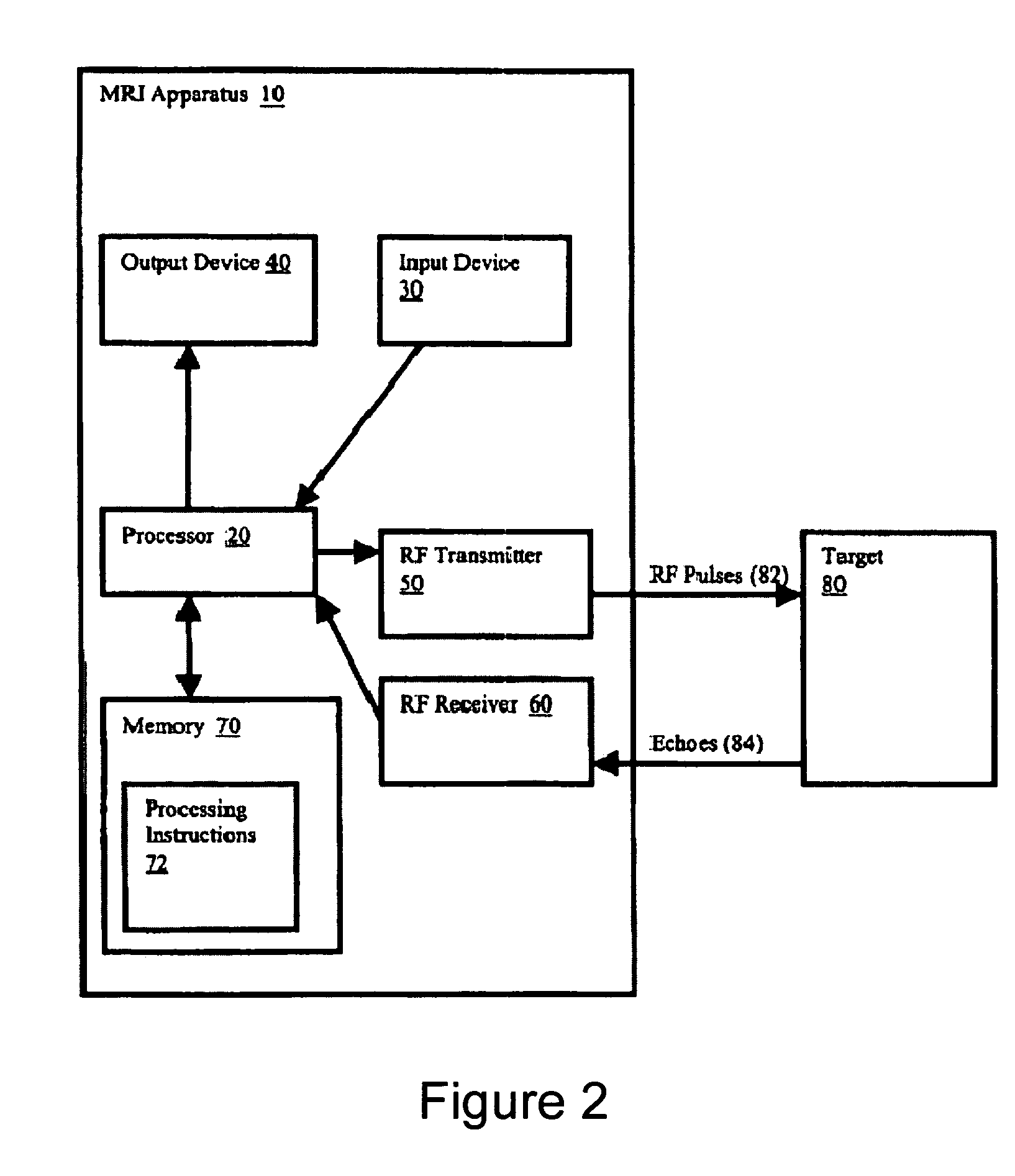Multi-echo magnetic resonance imaging method and system
a magnetic resonance imaging and multi-echo technology, applied in the field of multi-echo magnetic resonance imaging method and system, can solve the problems of insufficient resolution for other applications, early destruction of magnetization preparations, and certain problems, and achieve the effect of faster and more accurate perfusion maps
- Summary
- Abstract
- Description
- Claims
- Application Information
AI Technical Summary
Benefits of technology
Problems solved by technology
Method used
Image
Examples
first exemplary embodiments
[0050]FIG. 1 shows a flow diagram of one exemplary embodiment of a phase-train imaging (“PTI”) method 100 for generating magnetic resonance images according to the present invention. FIG. 2 shows an exemplary embodiment of an MRI apparatus 10 according to the present invention which may be used to implement the method 100 described below with respect to FIG. 1.
[0051]For example, as shown in FIGS. 1 and 2, a series of radio frequency (“RF”) pulses 82 can be transmitted in step 110 by an RF transmitter 50 of the MRI apparatus 10 toward a target 80. In one exemplary embodiment, the exemplary method 100 can be applied to cardiac MRI techniques, and the target 80 may be patient's cardiac region. The series of RF pulses 80 can generate echoes 84 from the target 80, which may be received (in step 120) by an RF receiver 60 of the MRI apparatus 10. In one exemplary embodiment, a single device, e.g., a transceiver, can be used as both an RF receiver 60 and an RF transmitter 50. Because the mu...
second exemplary embodiments
[0056]The MESSFP approach called Phase Train Imaging (PTI) (e.g., see V. M. Pai et al. “Phase train approach for very high temporal resolution cardiac imaging,” JCMR 2005; 7(1):98-99) can permit the acquisition of extremely high temporal resolution cine datasets in relatively short breath-hold durations. In this exemplary approach, unlike conventional MESSFP approaches, each set of echoes following an RF excitation pulse can acquire the same k-space line, and may be assigned to a different cardiac phase. Since all the echoes acquire the same k-space line for different cardiac phases, there may likely be no “complex” phase discontinuity in the “complex” phase-encode direction associated with this approach; since multiple echoes can be acquired, the number of RF pulses may be correspondingly smaller than that for single echo sequences, and effects of magnetization preparation pulses such as tagging can persist for a relatively longer duration. In addition, PTI is inherently more effic...
third exemplary embodiments
[0061]Exemplary Approach to Encode in all 3 Directions
[0062]For example, an echo train of 3 echoes can enable a first moment nulling in the Readout direction (beside the inherent zero-th moment nulling) at the end of each TR (repetition time), thus maintaining the conditions for trueFISP imaging (e.g., zero-th and first moments are generally nulled in the Slice Select and “complex” phase-encode directions in this approach). However, the 3-echo implementation of PCPTI can be primarily provided to encode the flow in-plane. In addition, because the implementation may have a long TR, it can potentially give rise to off-resonance banding artifacts if encoding for smaller velocities is attempted. An alternate approach can be to use a 2-echo implementation. One exemplary approach to achieving first moment nulling at the end of each TR with a 2-echo sequence can be to either implement a bipolar gradient following the second readout gradient, or to use a flyback gradient between the two read...
PUM
 Login to View More
Login to View More Abstract
Description
Claims
Application Information
 Login to View More
Login to View More - R&D
- Intellectual Property
- Life Sciences
- Materials
- Tech Scout
- Unparalleled Data Quality
- Higher Quality Content
- 60% Fewer Hallucinations
Browse by: Latest US Patents, China's latest patents, Technical Efficacy Thesaurus, Application Domain, Technology Topic, Popular Technical Reports.
© 2025 PatSnap. All rights reserved.Legal|Privacy policy|Modern Slavery Act Transparency Statement|Sitemap|About US| Contact US: help@patsnap.com



